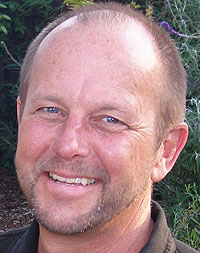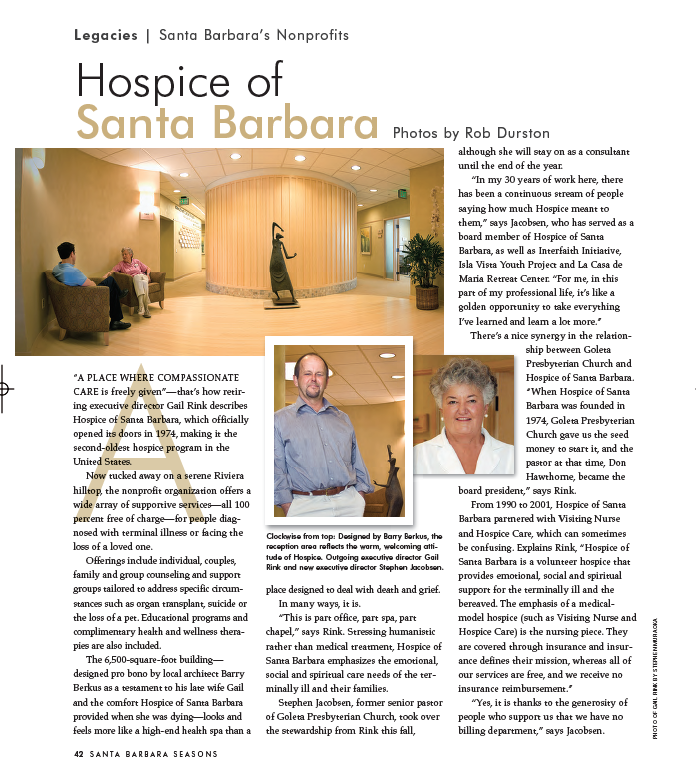After serving 16 years as Senior Pastor at Goleta Presbyterian Church, Stephen Jacobsen recently took over as Executive Director of Hospice of Santa Barbara.
Leslie Dinaberg: Did you always want to go into this kind of work?
Stephen Jacobsen: No. … I was a history major at UCSB a long, long time ago, so that whole thing of where do things come from, why is the world the way it is, it’s interesting to me. … I think too, in my ministerial work, it had a focus within a congregation. I did get involved in the community in a number of things over the years, but here at Hospice of Santa Barbara it’s like there are no boundaries. I can be anywhere in town listening and learning, so that’s pretty fun. It feels like a big toy box.
LD: Is that unusual to go into a school like UCSB and then go into the ministry?
SJ: When I was at UCSB I had no interest at all in religious stuff. …There are friends of mine that still can’t believe I ever went into this. But I was there in 1970, the bank was still smoking and lots of smoke was in the air of all kinds, so in that whole milieu it was a pretty exciting time, a pretty fascinating and wonderful time. … I made some decisions that weren’t too good for my health psychically as well as physically, and out of that I came to a personal crisis and then found a little grace point out there in the universe that kind of turned me around.
… Later, that led me into a relationship with the woman who is now my wife and we started going to a church and I was like, “I’ll be darned, every time I go here it’s kind of like this experience I had.” Before I thought organized religion was the most dull thing there ever was, but this has actually been going on for thousands of years, these writings in any tradition, so that’s what got me into it. UCSB was the last place … I never took a religious studies class there. … Personally, it’s a wonderful kind of a wonderful grace to where I kind of screwed up my life there. Here I get to go back and be a tax paying, responsible kind of a person who’s trying to help, and in that sense, I never thought I’d get back to Santa Barbara. But here I am, and in that sense it’s kind of a circle that I feel I wouldn’t have ever dreamed of.
LD: I know you served on the board before becoming executive director. What initially drew you to become involved with Hospice of Santa Barbara?
SJ: I’ve been in ministry 27 years and wherever I was people had such reverence for the work of Hospice and I got on the board in the 80s in Ventura County, when I was working in Santa Paula and it was an interesting board to be on. … Often in our culture we’re kind of like whoa, keeping things at arms length, and going through those things (loss of a loved one) kind of slows us down a little bit and makes us a little more reverent. So I thought this is interesting chemistry to be around where it’s people who have gone through some tough things in life. …Gail (Rink, the retiring executive director of Hospice of Santa Barbara) and I would do occasional programs together and I just loved hearing her speak.
… So with all that then, what got me interested in the job was I just felt personally in my life, I am 55 and I’ve been doing what I had done for 27 years and it was wonderful, but I thought I would be open to something different. I have a great appreciation for what this organization does, but also a sense that at this point in Hospice of Santa Barbara’s growth it really wants to–in addition to doing all of the care giving it does for people–move to work with others in the community.
… There’ s a movement, the Alliance for Living and Dying Well … it has these two goals, to do kind of the nuts and bolts thing of how can we get all the services well integrated? How can we get advanced directives very available to people? But then there’s this second kind of a thing that the alliance is very much wanting to do, which is take this message, to form and articulate this message and take it into the culture in which we live.
There’s a saying that I really like by a guy named Matthew Fox, which is, “If we savor more we buy less.” And so instead of saying I should buy less, it’s like if I come to terms with the idea my life is limited, then I start to enjoy each detail more and then I just don’t feel like I have to buy quite as much because what I am doing is really awesome.
LD: It’s amazing how quickly we lose touch too. When you’re in that moment of something big happening you think I’m going to remember this forever and then it fades and you go on with your life.
SJ: Yeah, yeah absolutely.
LD: As you evolve from a board member into the executive director that sounds like that’s going to be one of your things you’ll emphasize.
SJ: Yes, I think of my job as internal and external. Internal is the usual things that an executive director does, supporting and helping to manage the volunteers and staff and in that sense I kind of feel like a guardian. I want to protect my people and give them what they need but on the other end is this kind of external community relations thing and we’re interested in doing a lot of community education and collaborative things.
… One of my favorite definitions of leadership is the interweaving of relationships, so there’s one thing about setting the vision but there’s another thing about just seeing how all the relationships at all the different kinds of levels can just be woven together all the time so it’s strong, it’s not just one person out there in front of a charge. So a lot of what I look at is how to keep weaving relationships between Hospice of Santa Barbara and the healthcare people in town, the educational groups, all kinds of stuff.
LD: What do you do when you’re not working?
SJ: I love the beach, bicycling, I love to swim, I love opera, I love baseball. I’m a big Dodger fan, and there are 31 people that work here, but I don’t think there’s anyone else that cares, so I had to learn that the first week. … I love to travel. I don’t think I’ll be doing as much traveling here, but in my previous job had two weeks every year and I could save them on account, so I went to Mexico City and I loved kind of spiritual journeying, going to see the world. Here a lot of the journeying will be here in town.
Vital Stats: Stephen Jacobsen
Born: Nov. 8, 1952, San Bernardino
Family: Wife Ann; daughters Autumn (30, lives in Seattle), Alegra (21, lives in Austin, Texas), and Aria (18, a freshman at UC Santa Cruz); grandson Asher; Sophie the dog; and two chickens, Scarlett Johansson and Keira Knightley
Civic Involvement: Walter H. Capps Center for the Study of Ethics, Religion and Public Life (UCSB) advisory group; board member Hospice of Santa Barbara andIsla Vista Youth Project; recent past president of the Interfaith Initiative of Santa Barbara County; former board member of La Casa de Maria Retreat House
Professional Accomplishments: Senior pastor at Goleta Presbyterian Churchfor 16 years; Visiting Scholar at the UCSB Religious Studies Department; taught courses in history and religious studies at Heritage University in Toppenish, Wash.; pastor at Community Presbyterian Church in Wapato, Wash.
Best Book You’ve Read Recently: La Sumida Nursery “smallest ripe tomato” competition
Originally published in Noozhawk on October 6, 2008. Click here to read it on that site.


 “A PLACE WHERE COMPASSIONATE CARE is freely given”—that’s how retiring executive director
“A PLACE WHERE COMPASSIONATE CARE is freely given”—that’s how retiring executive director